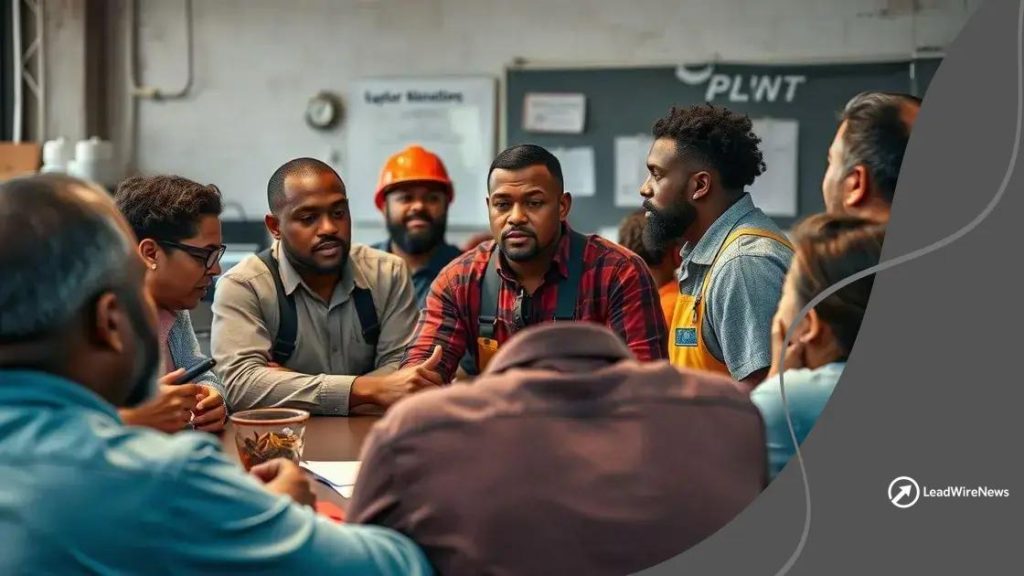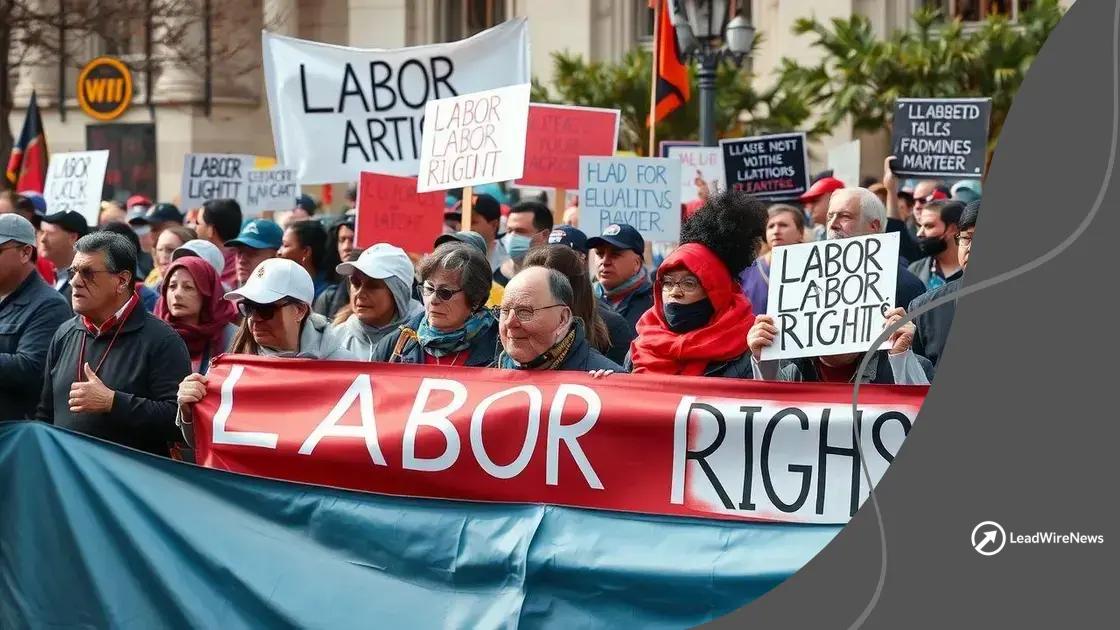Labor movement activities and negotiations that inspire change

Anúncios
The labor movement focuses on advocating for workers’ rights through collective bargaining, addressing issues like fair wages, safe working conditions, and employee representation while adapting to trends such as technology, remote work, and diversity.
Labor movement activities and negotiations are at the heart of creating fair workplaces. They offer a platform for workers to voice their concerns and build a better working environment. Curious about how these movements shape our lives? Let’s dive in.
Anúncios
Understanding the labor movement
The labor movement has played a crucial role throughout history in advocating for workers’ rights. By understanding the roots and evolution of these movements, we can better appreciate their significance. Labor movements have arisen in response to unfair practices, unsafe working conditions, and inadequate wages.
Historical Context
Initially, the labor movement began in the 19th century, sparked by the Industrial Revolution. As factories grew, so did the number of laborers who faced long hours and low pay. Workers recognized the need to unite, which led to the formation of early labor unions.
Key Objectives
The main goals of the labor movement include:
Anúncios
- Securing fair wages for workers
- Ensuring safe working conditions
- Establishing reasonable working hours
- Advocating for collective bargaining rights
These objectives continue to guide contemporary labor movements, reflecting the ongoing struggle for worker empowerment. Over time, legislation began to support labor rights, including the establishment of child labor laws and the right to organize.
As the labor movement evolved, it adapted to the changing economic landscape. The rise of technology and globalization presented new challenges. However, workers remained committed to advocating for their rights. Today, unions continue to fight for fair practices, not only in the workplace but also in broader social issues.
Modern Labor Movements
In recent years, we have seen a resurgence of interest in labor issues. More workers are joining unions or engaging in grassroots movements. This modern approach emphasizes inclusivity and aims to address concerns beyond wages, such as equity and justice.
Ultimately, understanding the labor movement means recognizing its transformative impact on society. These movements have changed the way we view work and the rights of employees, highlighting the importance of solidarity and collective action.
Key activities in labor negotiations
In labor negotiations, several key activities play a vital role in achieving successful outcomes for both workers and employers. These activities often involve thorough planning and strategic communication to address issues effectively. Understanding these activities helps all parties navigate the negotiation process more smoothly.
Preparation and Research
Effective labor negotiations begin with extensive preparation. This includes gathering data on industry standards, company policies, and worker grievances. By knowing what other companies offer, negotiators can set realistic goals.
Setting Clear Objectives
Establishing clear objectives is crucial. Both parties should outline their goals before discussions begin. Workers may seek:
- Higher wages
- Better benefits
- Safer working conditions
- Job security
Employers often have goals related to cost control and maintaining productivity. Clarity on both sides assists in reaching a compromise.
During negotiations, active listening and open communication are essential. Both labor representatives and management should be willing to hear each other’s concerns. Asking questions and seeking clarification helps prevent misunderstandings. This open dialogue creates an environment of trust that can lead to better outcomes.
Proposals and Counterproposals
As the discussions evolve, both parties present proposals and counterproposals. These documents outline what each side hopes to achieve. It’s important to document all agreements and disagreements carefully.
Negotiators may need to make concessions to reach an agreement. This means they might give up certain demands while securing others. Flexibility is vital, as it can lead to solutions that satisfy both sides.
Finally, reaching a consensus requires patience. Negotiations can be time-consuming, and both sides must remain committed to finding a fair resolution. Using a mediator can also help facilitate discussions when the parties reach an impasse, making it easier to break down barriers to agreement.
The role of unions in labor movements

The role of unions in labor movements is fundamental for advocating workers’ rights and improving conditions. Unions serve as collective voices for employees, allowing them to unite around common goals. By coming together, workers can negotiate better terms of employment and address workplace issues.
Advocacy and Protection
Unions advocate for various employee rights, including fair wages, safety standards, and health benefits. They work to protect workers from unfair treatment and discrimination. This advocacy often involves participating in political discussions and lobbying for labor-friendly legislation.
Collective Bargaining
One of the most significant functions of unions is collective bargaining. During this process, unions negotiate contracts on behalf of their members. The outcome can include:
- Increased wages
- Improved working conditions
- Enhanced benefits such as healthcare and retirement plans
- Job security measures
This negotiation process ensures that employees have a seat at the table when it comes to workplace policies. Through collective bargaining, unions empower workers to influence their employment conditions directly.
Additionally, unions provide resources and support to members. They often offer training programs to help workers enhance their skills and advance in their careers. Unions also provide legal assistance to members facing workplace disputes, ensuring that employees understand their rights and have proper representation.
Community and Solidarity
Beyond workplace issues, unions foster community and solidarity among workers. They organize events, rallies, and educational campaigns to raise awareness about labor rights. This creates a sense of belonging and a collaborative spirit among workers, encouraging them to support one another.
In conclusion, the role of unions in labor movements cannot be underestimated. By advocating for workers’ rights, negotiating better employment conditions, and providing support, unions play an essential role in shaping fair workplaces. Unions also unite workers, fostering strength and solidarity in their collective pursuit of justice in the workplace.
Challenges in labor movement negotiations
Negotiating within the labor movement comes with various challenges that can hinder progress. Understanding these obstacles helps both workers and employers navigate the negotiation process more effectively. One key challenge is the difference in priorities between labor and management.
Differences in Goals
Workers often seek higher wages and better working conditions, while employers focus on controlling costs. This fundamental difference can create friction. For instance, while unions may push for enhanced benefits, management may view these demands as excessive expenses. Balancing these priorities is essential for successful negotiations.
Communication Barriers
Effective communication is vital, but misunderstanding between parties can cause significant setbacks. Employers and union representatives might have different interpretations of terms, making dialogue difficult. Clear and open communication is necessary to bridge these gaps and ensure that both sides understand each other.
Furthermore, external factors can complicate negotiations. Economic downturns, shifts in public policy, and changes in industry standards might affect the bargaining power of unions. When economic conditions are weak, employers may be less willing to meet demands, leading to prolonged negotiations.
The Role of Public Opinion
Public perception of labor negotiations can also pose challenges. If the public views union demands as unreasonable, it can pressure unions to compromise. This external pressure might lead unions to accept less favorable terms than they initially sought. Additionally, negative media coverage can influence the bargaining process, making it increasingly difficult to reach an agreement.
In the end, navigating these challenges requires patience and skill. Both parties must remain committed to finding common ground. By understanding and addressing these obstacles, negotiators can work towards solutions that benefit all stakeholders involved in the labor movement.
Future trends in labor negotiations
Future trends in labor negotiations are evolving due to changes in technology, workforce demographics, and societal expectations. Understanding these trends can help both workers and employers navigate upcoming challenges and opportunities in negotiations.
Technology and Automation
One significant trend is the rise of technology in the workplace. Automation is changing the nature of work, leading to new discussions in labor negotiations. Workers will need to negotiate terms related to job security and retraining programs as more tasks become automated.
Remote Work Dynamics
The increase in remote work is also shaping negotiations. As more companies adopt flexible work policies, workers are requesting better work-life balance and support for remote workers. Important factors in these negotiations include:
- Flexible hours
- Home office stipends
- Access to mental health resources
- Clear communication protocols
Employers are adapting to these needs, which can lead to improved job satisfaction and retention.
Diversity and Inclusion Efforts
Another trend is the growing emphasis on diversity and inclusion. Workers are increasingly demanding equitable treatment and representation in the workplace. This focus on equity will likely shape negotiations, as companies may need to commit to specific diversity initiatives as part of their contracts. Issues related to gender pay gaps and workplace harassment will also continue to be crucial topics during negotiations.
Additionally, the role of global labor movements is becoming more prominent. As workers worldwide connect through digital platforms, there is a growing solidarity that can influence local negotiations. This global perspective allows workers to learn from one another and advocate for their rights collectively.
Adapting to these trends will require both unions and employers to be flexible and open to change. Successful labor negotiations in the future will likely involve innovative strategies and a commitment to collaboration. By focusing on these evolving trends, both sides can work together to create more equitable workplaces.
FAQ – Frequently Asked Questions about Labor Movement Activities and Negotiations
What are the main goals of labor movements?
Labor movements aim to secure fair wages, safe working conditions, and better benefits for workers.
How do unions impact labor negotiations?
Unions advocate for workers, negotiate on their behalf, and help ensure their rights are respected during negotiations.
What are some challenges in labor negotiations?
Challenges include differing priorities between workers and employers, communication barriers, and external economic factors.
What future trends are expected in labor negotiations?
Future trends include the impact of technology, the rise of remote work, and a growing emphasis on diversity and inclusion.